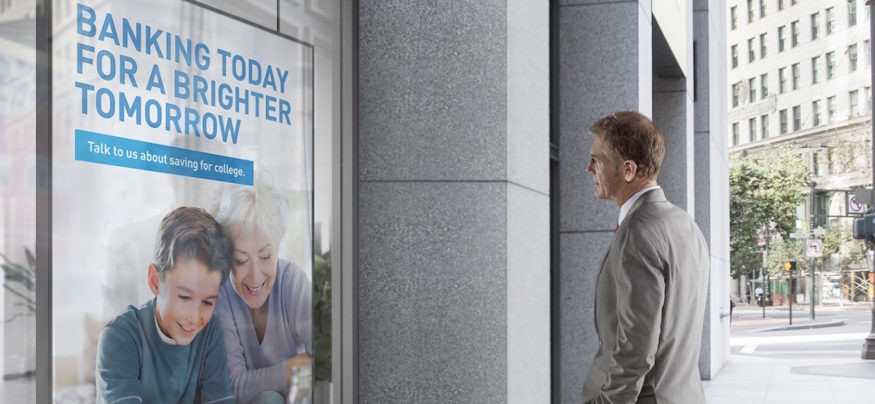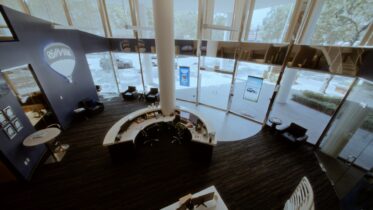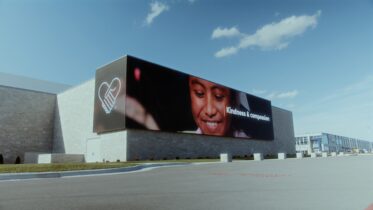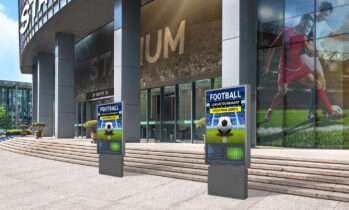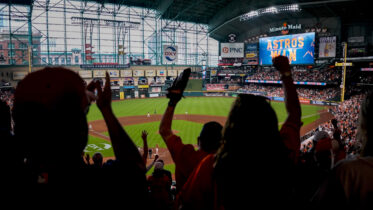Digital has made many of the simple aspects of everyday banking easier for consumers, but there’s still a strong role for traditional brick-and-mortar bank branches. Those branches — on main streets, in shopping malls and even in places like airports — are key elements in the constant retail banking effort to win new customers and build market share.
To start developing a new relationship with consumers, banks first need to get them inside a branch to start a conversation. That happens, in part, by having the sort of highly visible, immediately relevant messaging that will get people through doors and into local branches. For decades, banks have used posters and even old-school window painting. These days, a new breed of outward-facing digital signage displays offer the kind of flexibility and true stopping power that can make a difference in attracting new customers.
Using screens in window displays isn’t a new idea, but the technology has advanced to better deal with sunlight and glare, and costs have dropped to levels that make an ROI on window screens feasible.
Consider the difference: formerly, banks might have had a set of sun-bleached print posters, planned and printed weeks in advance, with generic, evergreen messaging that serves any branch. Contrast that with vivid, rich, motion messaging that’s targeted to the demographics and dynamics of the immediate area, scheduled to show different messages by time and date, and able to be updated on the fly. No contest, right?
But the CFO who has to sign off on posters that cost just dollars to produce — or on digital displays that will cost thousands — will want a stronger argument.
Compelling Research
Here’s what research tell us about banking in the digital age, from Accenture’s Banking Customer 2020 report, released in mid-2015. What matters most to consumers, based on feedback Accenture got from some 16,000 people, is pricing, value for money and quality of service. What was also clear is that consumers will switch or add financial services providers to get those things.
Accenture found that 18 percent of respondents have switched banks, and 27 percent have added providers. Almost 60 percent of consumers have more than two financial services providers. More than 30 percent have switched providers based on competitive pricing (things like rates and fees), service quality and value for their money.
The consulting giant suggests the future will be about everyday banks that are part of commercial and consumer lives, providing advice and facilitating services. A key aspect of that model is providing real-time communications and dynamically priced offers, and that only happens through digital means — from customers’ smartphones to the screens in windows that can create awareness, drive interest and initiate the branch relationship.
Those window displays are critical messaging points, because of the key drivers revealed by Accenture. To compete on pricing, marketers need the immediacy of digital. Communicating value, quality of service and trust requires richer messaging than what’s typically possible from a printed sign.
Unique Technology
Communicating to passing consumers from branch windows doesn’t work unless the technology is done right. Recent advances in commercial digital signage have addressed the unique challenges of reaching people from branch windows, in bright sunlight and throughout hours of steady heat.
Conventional display monitors have a brightness of 300 to 500 nits, which would be overpowered by sunlight. Modern outdoor displays have around 2,500 nits of lighting power, and they provide rich and vivid images even in midday sunlight, conquering the brightness and glare that would wash out other displays. These specialized displays are also designed to be viewed by people wearing polarized sunglasses by using technology that counteracts the impact of the lenses.
The displays are also custom-engineered to handle the heat and duty demands of 24/7 operation, and are equipped with sensors that tie the brightness output to lighting conditions. That means the display is automatically bright when it needs to be, and dialed back when the sun goes down. That technology has a direct impact on energy consumption and cost savings.
Flexible Deployment
Banks are using standalone displays in windows, or grouping them for high-impact stacks of displays, from single-wide totems to clusters that become video walls. Market penetration is climbing, as manufacturing costs have dropped and engineering challenges have been overcome. Daylight-readable displays will soon be common in retail banking.
Whatever the setup, the goal is the same — to use the stopping power and dynamism of digital displays to drive consumers inside branches.
Have a question about how to best integrate high brightness digital signage into bank branches or retail stores? Ask away in the comments section below.
